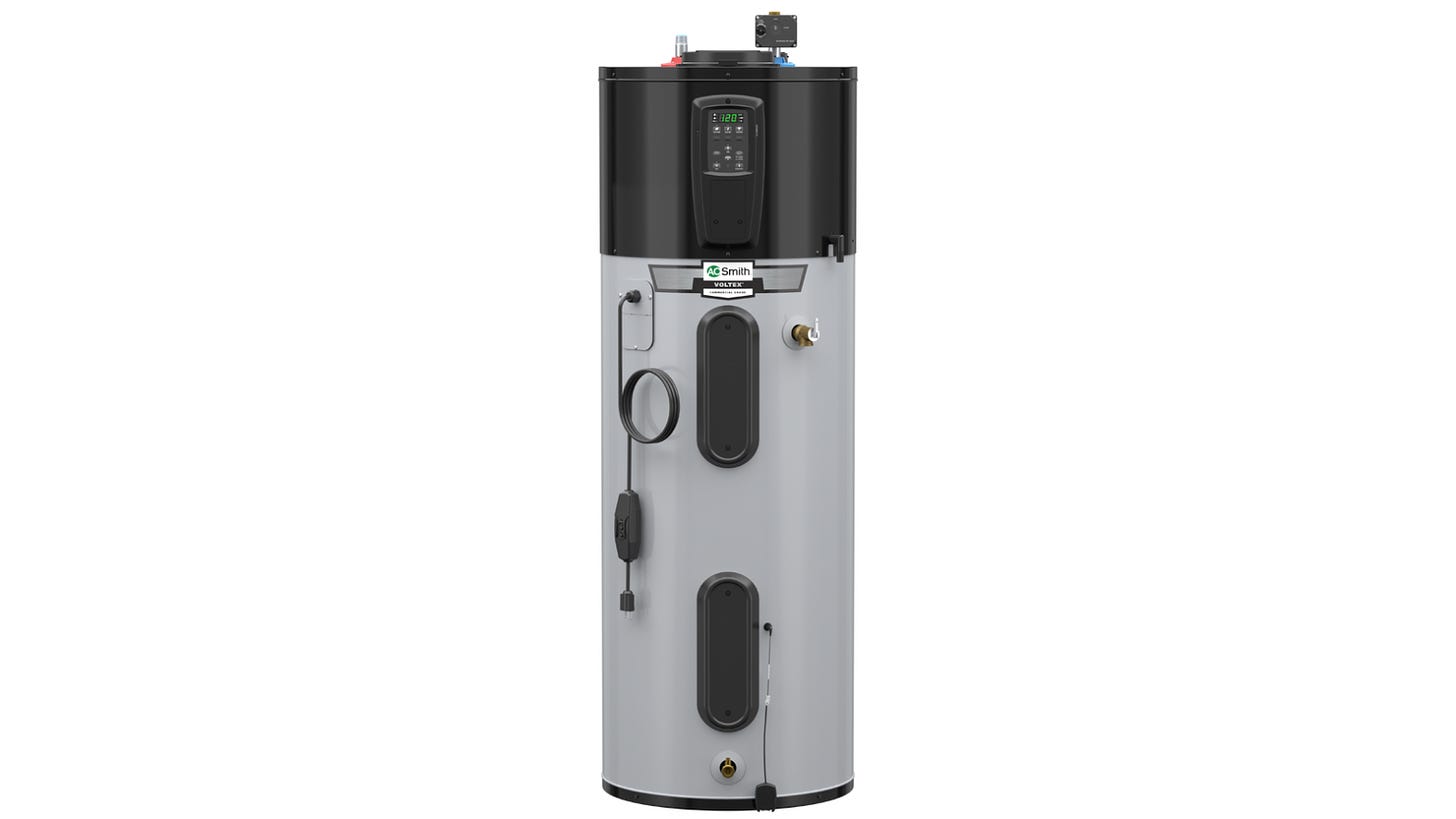Sign up for daily news updates from CleanTechnica on email. Or follow us on Google News!
A. O. Smith just released a 120V plug-in heat pump water heater (HPWH), which is the second model to arrive on the mass market (the first to market, Rheem, I reviewed here). It is an exciting product with some innovative designs that allows many households to more easily replace their gas water heaters with heat pumps. It uses nifty technology to provide lots of hot water while still (miraculously) only plugging into the same standard 120-volt outlet where you charge your cell phone.

How The 120V Version was Born
The idea for the 120V plug-in HPWH was born five years ago. Manufacturers and a large group of stakeholders came together at a conference in California to dream up the idea of a HPWH that could plug into a standard outlet. That dream has now become reality. The 120-volt heat pump water heater is designed for same-day gas water heater replacements. A water heater that plugs into a standard outlet avoids having to run a new 240-volt line from an electrical panel to the water heater location, which can save a lot of time and money during installation.
But for the nearly half of American homes that have an electric water heater, this product is not for you. Your home already has 240 volts of electricity powering your water heater, so the 240-volt HPWH (that has been on the market since 2009), is a better option because it has backup electric resistance elements that can recover faster during periods of high demand.
After the initial stakeholder and industry meeting 5 years ago, A. O. Smith went to the drawing board to create a 120V HPWH. The company went through a long and rigorous product development process and researched how people use their water heaters and what they expect from them. A key task was to create a water heater that wouldn’t disappoint customers by not producing enough hot water, while at the same time drawing only as much energy as a standard plug could provide. Another challenge was to create a water heater that was efficient enough it would save households money even in areas where electricity is expensive and gas is cheap.
4 Similarities With The 240V HWPH
A. O. Smith’s 120-volt product development coincided with the next generation of 240-volt HPWHs they were building called the Voltex AL (which I reviewed here). The 120V version utilizes many of the same parts and has many of the same features of the Voltex AL which include:
1) Top water connections (which make it easy to replace a standard gas water heater)

2) Extremely quiet operation at 45 decibels because the water heater uses a blower rather than a fan
3) Only requiring 450 cubic feet of air to run efficiently
4) Smart connectivity and an easy to use app where you can set your water heater to run during times of cheaper electricity.

7 Differences From The 240V HWPH
But A. O. Smith designed its plug-in water heater with additional features that allow it to function on only 120 volts of electricity. These include:
1) Integrated smart valve: A. O. Smith’s 120-volt HPWH has a smart mixing valve that is integrated into and inside the water heater (which is different from Rheem’s which is on the outside with a cover on it). This smart valve is crucial because it allows the water heater to store water at a much higher temperature, usually twenty degrees hotter than what will actually come out at your faucet. Storing water hotter means you’ll have more hot water (an estimated 32% more for water 20 degrees hotter), which is important if the water heater recovers more slowly (which the 120-volt naturally does). Thus if you buy a 50-gallon HPWH and heat it to 140 degrees (with an externally installed mixing valve), it can provide as much hot water as a 65-gallon water heater heated to the standard 120 degrees. A. O. Smith’s smart valve does this automatically, so you set the water temp you want and the water heater will heat the water hotter and then mix down to the setpoint temperature before sending it to the home.
2) Guidance to upsize the tank two sizes: Heat pumps heat water slower than gas water heaters, so sizing is important. A. O. Smith (along with other manufacturers) recommends that homeowners upsize their tank two sizes when going from a gas to a 120-volt HPWH. Just like the mixing valve, a bigger tank will store much more hot water reducing the likelihood that a household will ever run out (or in industry lingo “have a cold water event”). A. O. Smith has a handy chart to show what upsizing looks like — a 30- to 40-gallon gas water heater should be upsized to a 66-gallon heat pump, while a 50-gallon gas water heater should be upsized to an 80-gallon heat pump. Keep in mind, more tank capacity will mean you’ll be installing a water heater that is larger than the one it is replacing. The 120-volt HPWHs are usually 6 feet tall (instead of the standard 5 feet) and 24 inches (instead of the standard 22 inches). I replaced a 40-gallon gas with a 50-gallon 120-volt HPWH that I keep at 140 degrees and this has worked fine in my experience. But the home also has only 1 shower with a very efficient showerhead.

3) More expensive: The added features and (currently) low production volume make 120-volt HPWHs more expensive (for example the 50-gallon costs $2,159, the 66-gallon costs $2,594, and the 80-gallon costs $3,251 at Lowes) than the 240-volt HPWH (which typically costs between $1,600 and $1,900). This extra expense could be well worth it though, especially if it allows you to do a same-day gas-to-heat-pump installation and saves you from having to run an electrical wire or upsize an electrical panel. All of A. O. Smith’s HPWHs also qualify for the 30% federal tax credit and local utility rebates.
4) Lower global warming potential (GWP) refrigerant: If the refrigerant in heat pumps (and cars and fridges) escapes, it can contribute to global warming as current refrigerants trap much more heat than CO2. But refrigerant GWP levels are improving, and A. O. Smith has become the first major water heater manufacturer to use low GWP refrigerant using the refrigerant R-513A in this 120-volt plug in heat pump water heater. Kudos to the company for doing that.
Chip in a few dollars a month to help support independent cleantech coverage that helps to accelerate the cleantech revolution!
5) Electric elements are smaller: Electric water heaters heat water like toasters heat toast, with what are called electric resistance elements. 240-volt HPWHs have large electric resistance elements but don’t use them much, usually relying on their efficient heat pumps to heat water. The A. O. Smith 120-volt HWPH has small 900-watt electric resistance elements, unlike the Rheem 120-volt which doesn’t contain elements. These 900-watt elements can’t provide very much heat and won’t ever turn on in normal operation. But they are there for emergencies, like when temperatures are outside of the heat pump’s operating range of 37 – 120 degrees or if for some reason the heat pump were to break.
6) Suitable for cold climates: The fact that A. O. Smith’s 120-volt model has small electric elements means the company is making this product available everywhere, including colder climates. Rheem, on the other hand, hasn’t marketed its 120-volt HPWH in cold climates because it doesn’t have an electric resistance backup. As you go further north in the U.S., it’s more likely that the water heater is installed in the home in a utility closet or basement, so temperatures are unlikely to drop below the heat pump’s operating range and in my humble opinion, you’re probably fine either with or without elements. But these small elements add an extra peace of mind that the 120-volt will provide hot water even in extreme conditions.
7) Lower efficiency: Storing water at a hotter temperature (to make sure homes have enough of it) means the 120-volt HPWH is usually 20-25% less efficient than its 240-volt counterpart (for the water heater nerds, the 120-volt has a 3.0 UEF while the 240-volt has a 3.8 or higher UEF). But 120-volt HPWHs are still 3X more efficient than electric resistance water heaters and 5X more efficient than gas water heaters. So while it has slightly lower efficiency than the best HPWHs, the 120-volt is still a gamechanger in saving energy and carbon emissions. A. O. Smith also believes the 120-volt will save on utility bills over gas in virtually every part of the country, and this squares with the findings from the first 120-volt field study conducted by the Advanced Water Heating Initiative (full disclosure — I work on this initiative), which found that 72% of homes saved on their utility bills in California which has some of the highest electricity rates in the country.

What does all this add up to? A plug-in water heater that can work well in almost any home and climate. A. O. Smith’s 120-volt HPWH, while not cheap, is a testament to good engineering and design that does the near impossible; it produces and stores lots of hot water while using hardly any energy and only plugging into a standard outlet. For the half of the U.S. looking to save money on utility bills and 1 ton of CO2 emissions per year, this product allows you to do so quickly and easily and in virtually any climate.
Have a tip for CleanTechnica? Want to advertise? Want to suggest a guest for our CleanTech Talk podcast? Contact us here.
Latest CleanTechnica TV Video
[embedded content]
Advertisement
CleanTechnica uses affiliate links. See our policy here.
- SEO Powered Content & PR Distribution. Get Amplified Today.
- PlatoData.Network Vertical Generative Ai. Empower Yourself. Access Here.
- PlatoAiStream. Web3 Intelligence. Knowledge Amplified. Access Here.
- PlatoESG. Carbon, CleanTech, Energy, Environment, Solar, Waste Management. Access Here.
- PlatoHealth. Biotech and Clinical Trials Intelligence. Access Here.
- Source: https://cleantechnica.com/2024/02/28/a-o-smiths-new-120v-heat-pump-water-heater-allows-you-to-plug-it-into-a-standard-outlet/
- :has
- :is
- :not
- :where
- $UP
- 1
- 120
- 20
- 2009
- 22
- 24
- 321
- 400
- 45
- 5
- 6
- 8
- a
- accelerate
- actually
- add
- added
- Added Features
- Additional
- advanced
- Advertise
- Affiliate
- ago
- AIR
- AL
- All
- allow
- allows
- almost
- along
- already
- also
- American
- an
- and
- Another
- any
- app
- app allows
- ARE
- areas
- arrive
- AS
- At
- automatically
- available
- avoids
- Backup
- BE
- because
- become
- been
- before
- believes
- below
- BEST
- Better
- between
- bigger
- Bills
- Blue
- board
- born
- Break
- Building
- but
- buy
- by
- california
- called
- came
- CAN
- Capacity
- carbon
- carbon emissions
- cars
- cell
- challenge
- charge
- Chart
- cheap
- cheaper
- Choose
- cleantech
- Cleantech Talk
- Climate
- co2
- co2 emissions
- coincided
- cold
- come
- company
- conditions
- conducted
- Conference
- Connections
- Connectivity
- contain
- content
- contribute
- Cost
- Costs
- could
- Counterpart
- country
- courtesy
- cover
- create
- credit
- crucial
- cubic
- Current
- Currently
- Customers
- Demand
- Design
- designed
- designs
- Development
- differences
- different
- disclosure
- do
- does
- Doesn’t
- doing
- dollars
- Dont
- down
- drawing
- dream
- Drop
- during
- easily
- easy
- efficiency
- efficient
- EIA
- either
- Electric
- electricity
- elements
- embedded
- Emissions
- energy
- Engineering
- enough
- especially
- estimated
- Even
- EVER
- Every
- everywhere
- example
- exciting
- expect
- expense
- expensive
- experience
- externally
- extra
- extreme
- fact
- false
- faster
- faucet
- Features
- Federal
- Feet
- few
- field
- findings
- fine
- First
- five
- For
- found
- from
- full
- function
- further
- gamechanger
- GAS
- generation
- Global
- global warming
- Go
- going
- good
- Group
- Guest
- guidance
- Half
- hand
- handy
- hardly
- Have
- having
- helps
- High
- higher
- highest
- Home
- Homes
- HOT
- household
- households
- How
- HTTPS
- humble
- i
- idea
- if
- image
- important
- impossible
- improving
- in
- inches
- include
- Including
- independent
- industry
- initial
- Initiative
- innovative
- inside
- installation
- installed
- installing
- instead
- integrated
- into
- IT
- ITS
- just
- Keep
- Key
- KUDOS
- large
- larger
- less
- levels
- like
- likelihood
- likely
- Line
- links
- local
- location
- Long
- looking
- LOOKS
- Lot
- lots
- Low
- lower
- major
- make
- Making
- Manufacturer
- Manufacturers
- many
- Market
- marketed
- Mass
- max-width
- mean
- means
- meeting
- mind
- mix
- Mixing
- model
- money
- Month
- more
- more efficient
- much
- my
- naturally
- Near
- New
- news
- next
- Nifty
- normal
- North
- now
- of
- on
- ONE
- only
- operating
- operation
- Opinion
- Option
- or
- Other
- our
- out
- outlet
- outside
- over
- panel
- part
- parts
- peace
- People
- per
- periods
- phone
- pipes
- plato
- Plato Data Intelligence
- PlatoData
- player
- plug
- podcast
- policy
- potential
- Powering
- Prioritize
- probably
- process
- produces
- producing
- Product
- product development
- Production
- provide
- pump
- pumps
- qualify
- quickly
- quiet
- range
- Rates
- rather
- Reality
- reason
- recommends
- Recover
- Recovers
- Red
- reducing
- released
- relying
- replace
- researched
- Resistance
- reviewed
- rigorous
- Run
- s
- same
- Save
- saved
- saving
- Savings
- Second
- see
- sending
- set
- should
- show
- similarities
- since
- sizes
- slightly
- slower
- Slowly
- small
- smaller
- smart
- smith
- So
- some
- squares
- stakeholder
- stakeholders
- standard
- Still
- store
- stores
- storing
- Study
- suggest
- suitable
- support
- sure
- Talk
- tank
- Task
- tax
- tax credit
- Technology
- testament
- than
- that
- The
- their
- Them
- then
- There.
- These
- they
- this
- though?
- Through
- Thus
- time
- times
- tip
- to
- toast
- together
- Ton
- top
- TURN
- tv
- twenty
- two
- typically
- u.s.
- unlike
- unlikely
- Updates
- us
- use
- uses
- using
- usually
- utility
- utilizes
- valve
- version
- very
- Video
- virtually
- volume
- want
- was
- Water
- WELL
- went
- were
- What
- when
- whether
- which
- while
- will
- Wire
- with
- without
- Work
- worked
- worked fine
- worth
- would
- years
- you
- Your
- youtube
- zephyrnet





